Did you know that speaking two languages can delay Alzheimer’s by up to five years1? This fact shows how learning a new language changes our brains. I want to dive into the world of bilingualism and its many benefits.
Today, with about 6,800 languages spoken, bilingualism is more common than ever2. The perks of speaking more than one language go way beyond just talking to people. They help our brains work better and deepen our understanding of different cultures.
Studies reveal that bilinguals often do better in solving conflicts and use more brain areas for focus and control1. This means learning a new language not only makes us better at communicating but also sharpens our thinking skills.
The effects of bilingualism on our brains are amazing. Bilinguals can pick up on sounds better in loud places and have more brain areas for language1. These changes show how learning a new language changes our brain’s structure.
What’s even more interesting is bilingualism might help keep our brains sharp as we get older. A study found bilingual Alzheimer’s patients started showing symptoms five years later than others1. This hints that learning a new language could be key to keeping our minds agile.
Key Takeaways
- Bilingualism can delay Alzheimer’s onset by up to five years
- There are about 6,800 languages spoken globally
- Bilinguals excel in conflict management and attention tasks
- Language learning increases gray matter in specific brain regions
- Bilingualism serves as a form of cognitive reserve in aging
Understanding Bilingualism and Its Prevalence
In today’s world, more and more people speak two or more languages. About one in three people around the globe speak more than one language, showing how diverse languages are becoming3. This is especially true in cities, where up to half of students in places like Toronto speak a language other than English3.
Defining Bilingualism and Multilingualism
Bilingualism means speaking two languages well. Multilingualism is when someone knows more than two languages. There are different opinions on what it means to be bilingual, from speaking a second language fluently to using two languages in daily life4. It can start from birth or later in life.
Global Statistics on Bilingual Populations
Many people speak more than one language. In California, over 50% of kindergartners are expected to speak a language other than English by 20353. Also, 56% of children of immigrants in the U.S. speak two languages5. This change is affecting our schools and how we talk to each other.
The Rise of Language Learning in the Modern World
Many factors are making more people learn new languages. These include moving to a new country, doing business abroad, traveling, and going to school in another language4. People learn new languages for many reasons, like family, work, or to understand different cultures4. Learning languages is becoming more important in our connected world.
| Factor | Impact on Bilingualism |
|---|---|
| Migration | Increases exposure to multiple languages |
| International Trade | Necessitates multilingual communication |
| Education Programs | Promote language learning from early age |
| Globalization | Encourages linguistic diversity |
As we move towards a future with more languages, it’s important to know the good and the tough parts of speaking two languages. The growing number of languages in our communities brings new chances for sharing cultures and growing our minds.
The Phenomenon of Language Co-activation
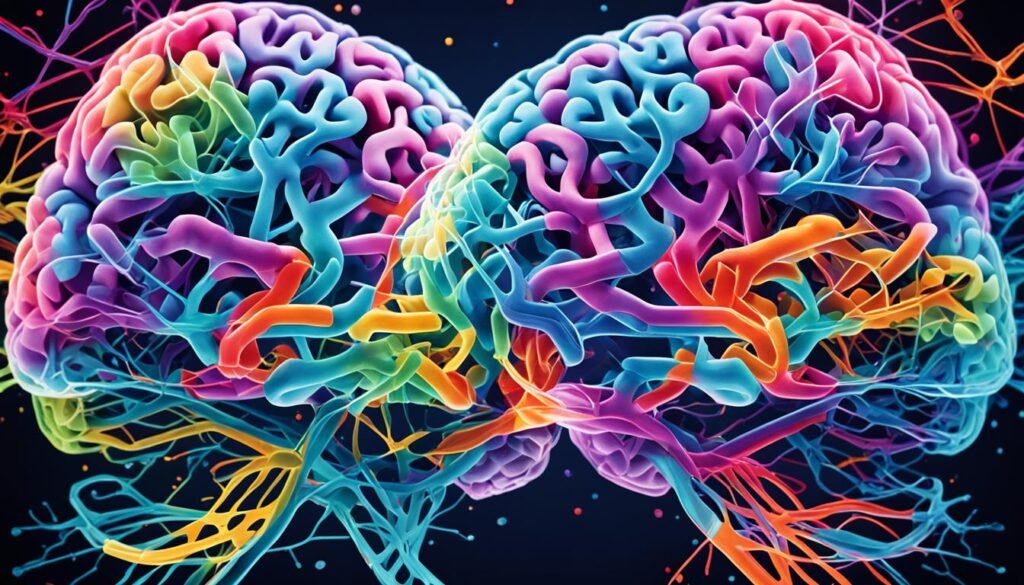
Language co-activation is a key part of how bilingual people process languages. It happens when the brain uses more than one language at once during learning and speaking6.
Studies show that bilinguals keep their other language active even when speaking one. This can make language use easier and harder at the same time6.
Research finds interesting things about language co-activation. For example, Spanish-English bilinguals who learned Spanish later didn’t mix languages when speaking English. But Russian-English bilinguals often mixed their languages when listening to their first language6.
How much language mixing happens can depend on many things. If two languages share sounds, it can make switching between them easier or harder. Sometimes, sharing sounds can slow down using one language6.
Code-switching is a common way bilinguals switch between languages. It means moving between languages in one conversation or even within a sentence. This shows how flexible bilingual language use can be.
“Bilingual individuals possess a single complex bilingual repertoire rather than two separate linguistic systems.”
Recent studies look into how bilinguals think about language. They talk about a bilingual constructicon, which means how bilinguals see language units together. This view sees language as one system, not separate ones7.
| Age Group | Language Pair | Focus of Study |
|---|---|---|
| 4, 6, and 8 years old | German-French | Idiosyncratic utterances |
| Adults | Various | Caused-motion events |
Learning about language co-activation helps us make better language learning plans and support bilingual education. It shows us the complex ways bilinguals manage multiple languages at once.
Cognitive Control in Bilingual Individuals
Bilingualism changes how we manage our minds. It shapes our mental processes. Studies show how it affects executive function, flexibility, and attention in bilinguals.
Inhibitory Control Mechanisms
Bilinguals often have better control over their thoughts. Studies reveal that bilingual kids have stronger working memory and better control over distractions8. This comes from switching between languages all the time.
Task Switching Abilities
Bilinguals are great at switching tasks. They show less mental effort and quicker responses when switching between languages or tasks9. This skill helps them be more flexible in real life.
Conflict Management Skills
Bilinguals are also better at handling conflicts. Research using the Stroop task shows bilinguals handle distractions better than those who speak one language10. This skill helps them stay focused in tough situations.
| Cognitive Skill | Bilingual Advantage | Potential Real-World Benefit |
|---|---|---|
| Inhibitory Control | Enhanced working memory and stimulus inhibition | Improved focus in distracting environments |
| Task Switching | Faster reaction times in switching tasks | Better multitasking abilities |
| Conflict Management | Reduced interference in Stroop tasks | Enhanced decision-making in complex situations |
Research on bilingualism is growing. It shows bilinguals have big cognitive benefits. These include better problem-solving skills in daily life.
Bilingualism and Executive Function
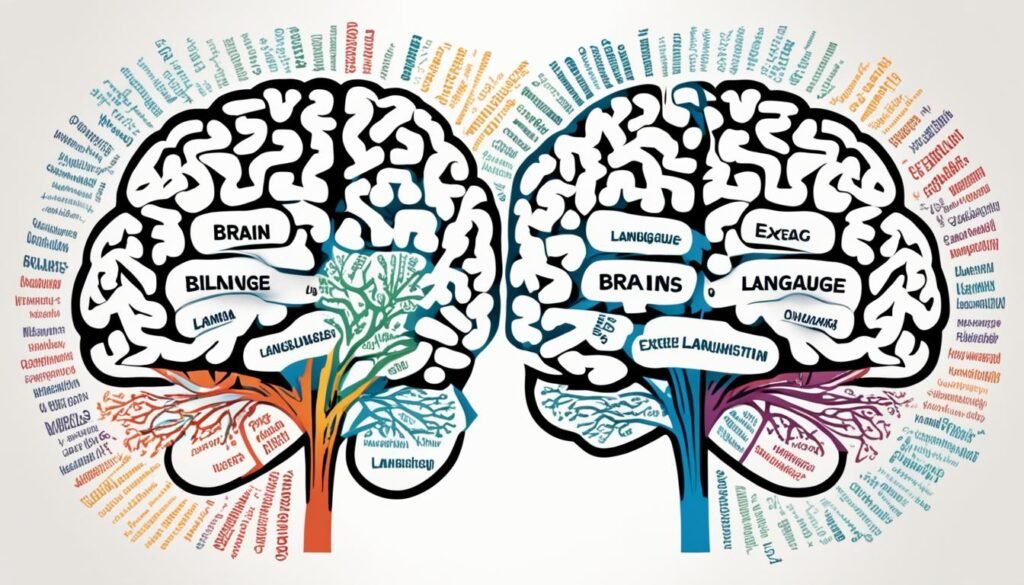
Bilingualism is key to our brain’s ability to control and process information. It boosts executive function, which includes working memory, stopping unwanted thoughts, and changing our minds. These skills help us solve problems and handle complex tasks every day.
Research shows bilinguals often beat those who speak one language in tests of executive function11. This is because they practice using two languages, which makes their brains better at controlling information and managing tasks.
Bilingualism does more than just improve language skills. It changes how our brains work, affecting both language and non-language tasks12. Bilinguals are better at stopping unwanted thoughts, switching between tasks, and updating their memory12.
Here are some areas where bilinguals do better:
- Stroop color-naming tasks
- Simon paradigm tasks
- Flanker paradigm tasks
- Cue-switching tasks
- Wisconsin Card Sorting Task (WCST)
- Spatial location memory tasks
In these tasks, bilinguals usually beat those who speak one language12. This shows that the skills they use in managing two languages help them in other areas too, making them better problem solvers.
Bilingualism also helps with managing emotions, which is part of executive function. This skill is important for getting along with others, adjusting to social situations, and doing well in school12.
While the benefits of bilingualism are clear, some studies have found different results. This highlights the need for more research to understand how language affects our minds.
| Executive Function Component | Bilingual Advantage |
|---|---|
| Inhibitory Control | Enhanced ability to suppress irrelevant information |
| Cognitive Flexibility | Improved task-switching and mental agility |
| Working Memory | Better information retention and manipulation |
| Emotion Regulation | Improved emotional processing and social skills |
Neurological Changes Associated with Bilingualism
Research in neurolinguistics shows how bilingualism changes the brain. Studies in cognitive neuroscience reveal big changes in bilingual brains. These changes show how our brains can change and adapt.
Brain Activation Patterns in Bilinguals
Bilingual brains work differently during language tasks. Babies from bilingual homes show they can tell languages apart early on13. This early start helps their brains grow better at understanding languages.
This early start gives bilingual babies a head start in language skills13. They are better at seeing and understanding languages.
Structural Changes in the Bilingual Brain
Bilingual brains change more than just how they work. They also change in structure. These changes help with language and thinking skills.
These changes can make bilingual people think better and may even delay dementia by 4-5 years14.
Impact on Gray Matter Volume
Bilingualism makes the brain’s gray matter thicker in areas important for language. This thicker gray matter means better language skills and earlier learning of a second language.
Doing brain-stimulating things like speaking two languages keeps the brain sharp. It also lowers the risk of memory loss later on14.
Bilingual people usually do better in tasks that need good control and focus14. This advantage stays as they get older. It may even protect against brain problems and diseases14.
Learning a second language helps make new connections in the brain. This is key for learning and remembering things14.
Enhanced Learning Capabilities in Bilinguals
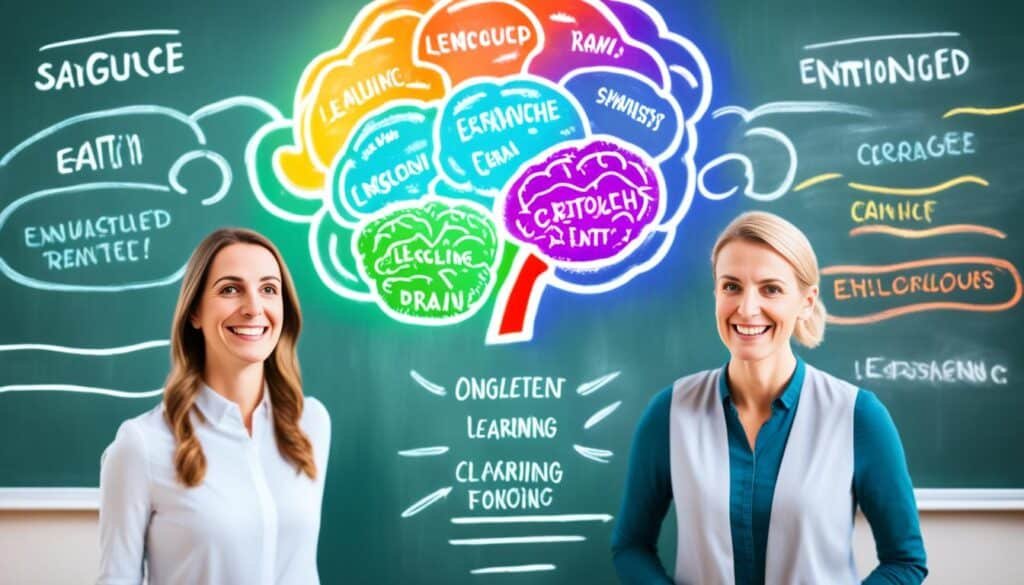
Being bilingual boosts learning in many areas. Studies show bilinguals do better in learning new words and artificial languages. This is because their brain works hard to manage two languages.
Bilingual kids in preschool do better in sorting tasks than kids who speak only one language15. They solve problems more easily and think more flexibly. This skill helps them in many areas, not just with languages15.
Bilingual kids are creative and solve problems better16. These skills stay with them as they grow up. Adults who speak two languages have better control over their thoughts and actions16.
Learning two languages changes the brain. It makes certain areas thicker and more connected1617. This helps with memory and thinking skills.
Bilingual people also have an edge in the job market. From 2010 to 2015, the need for bilingual workers went up by over 150%17. Companies want people who can talk to different cultures, making bilinguals very valuable17.
Starting bilingual education early is key. It helps kids do better in school and think better for life17. As the world gets more connected, learning a language early is more important than ever. It opens doors to better learning and opportunities.
Bilingualism and Cognitive Reserve
Bilingualism is key to keeping our brains sharp and fighting off cognitive decline as we get older. It helps build a strong cognitive reserve. This reserve is the brain’s ability to bounce back from damage.
Understanding Cognitive Reserve
Cognitive reserve helps our brains stay strong against aging. It’s like saving up mental strength for later. Learning multiple languages can boost this reserve, helping to delay cognitive problems.
Bilingualism’s Impact on Cognitive Resilience
Studies show bilingualism makes our brains more resilient. Research finds bilingual people may start showing dementia symptoms 4.7 years later than those who speak one language18. This is especially true for those with less education18.
Long-term Cognitive Benefits for Older Adults
Bilingual older adults often have better thinking skills and brain health1819. Even if they get Alzheimer’s, their thinking skills can stay strong, despite more brain shrinkage19.
Some debate exists in this field, but most studies show bilingualism is good for our brains as we age19. Learning more languages could be a great way to keep our minds sharp for life.
The Impact of Bilingualism on Creativity
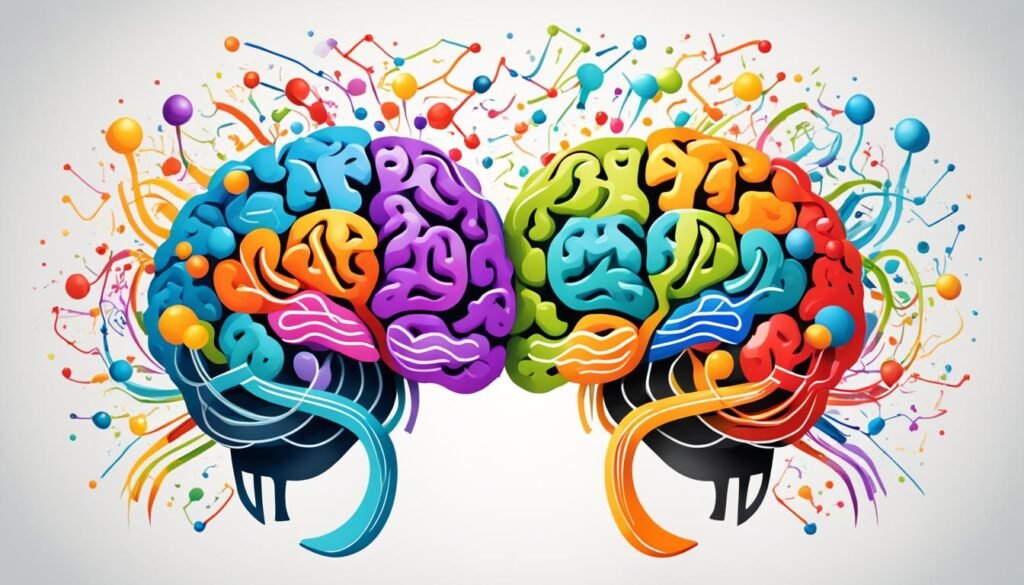
Being bilingual is linked to better creative skills. Studies show that those who speak two languages do better in solving problems and focusing20. This is because learning two languages helps improve how the brain controls tasks.
Bilinguals often score well in tests that measure creative thinking21. These tests look at finding one solution and coming up with many ideas. This shows bilinguals are good at both finding a single answer and thinking of many options.
Research shows bilingual kids and teens do better in some creative tasks22. But this edge fades as they get older. Bilinguals are also quicker and better at switching between tasks, showing they’re more flexible in their thinking21.
Learning two languages helps with controlling the mind. This control is key for solving problems and thinking creatively21. So, bilinguals tend to be more innovative and good at solving problems.
| Aspect | Bilingual Advantage |
|---|---|
| Convergent Thinking | Higher scores on Remote Associates Test |
| Divergent Thinking | Better performance on Torrance Test of Creative Thinking |
| Cognitive Flexibility | Quicker activation in switch tasks |
| Problem-Solving | Enhanced performance compared to monolinguals |
But, the effect of bilingualism on creativity can change depending on the culture and what kind of creativity is being tested. The European Commission found over 200 studies linking bilingualism to creativity20.
Language Learning and Cognitive Flexibility
Learning a new language is a great way to improve your cognitive flexibility. This skill is vital in today’s fast-changing world. It helps us adapt quickly and solve problems efficiently.
Defining Cognitive Flexibility
Cognitive flexibility means our brain can switch between different tasks and ways of thinking. It’s part of executive function, making complex situations easier to handle. People who speak two languages often do better in solving problems and being creative23.
How Language Learning Enhances Mental Agility
Learning a new language makes our brains work in new ways. It boosts memory, multitasking, and attention span23. In the U.S., the number of people learning two languages has gone up by 24% in ten years. This shows more people see the value in it24.
Real-world Applications of Improved Cognitive Flexibility
Being able to switch between languages helps in real life. People who speak two languages make better decisions and manage tasks well23. They also have better focus, think more deeply, and are more flexible even as kids24.
| Cognitive Skill | Benefit for Bilinguals |
|---|---|
| Problem-solving | Enhanced creativity and adaptability |
| Memory | Improved working memory capacity |
| Attention | Increased focus and selective attention |
| Executive Function | Better decision-making and task management |
These benefits don’t stop as we get older. Speaking two languages can protect against losing cognitive skills, possibly even delaying dementia by years23. Clearly, learning languages is a key way to keep our minds flexible and healthy.
Bilingualism and Attention Control
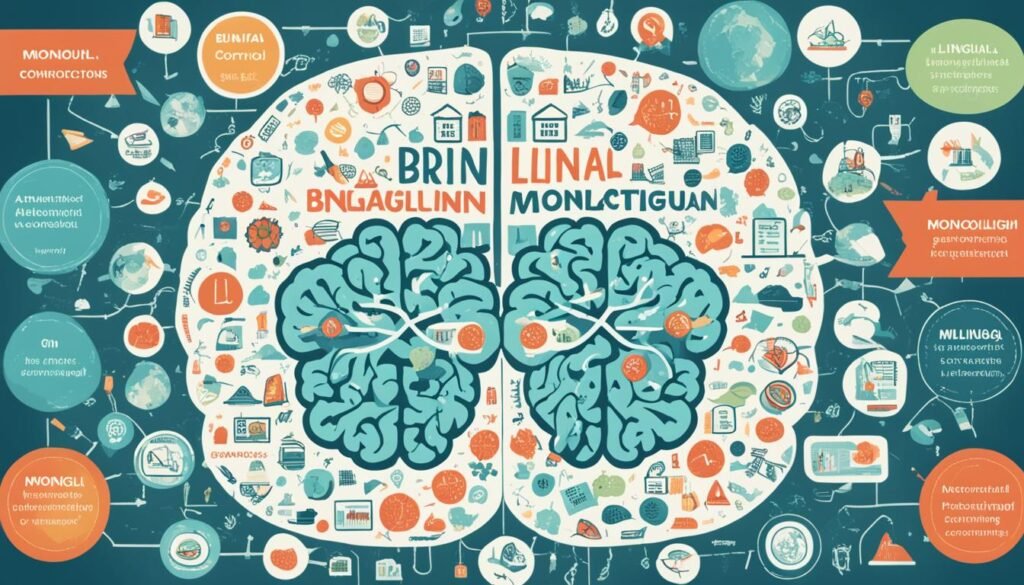
Being bilingual makes our minds better at focusing and sorting out information. It’s like a mental workout that boosts our ability to pay attention and ignore distractions. Research shows bilingual people do better in tasks that need a lot of focus25.
For bilinguals, the brain gets a lot of practice in controlling its functions like focus and stopping unwanted thoughts. They’re better at ignoring things that aren’t important and handling many things at once2526. This comes from always switching between languages and keeping one language from taking over.
Studies show our brain skills can change over time, influenced by things like learning a new language25. This means learning a new language at any age could make our brain work better.
Kids who speak two languages are better at solving problems, thanks to their sharp focus27. They’re good at picking out what’s important, a skill they get from using multiple languages.
| Cognitive Skill | Bilingual Advantage |
|---|---|
| Selective Attention | Better at focusing on relevant information |
| Cognitive Inhibition | Enhanced ability to ignore distractions |
| Task Switching | Improved mental flexibility |
There’s ongoing debate about how much bilingualism helps our brains, but many studies say it does. Learning a new language can make our brain work better, no matter who we are.
The Role of Age in Bilingual Cognitive Benefits
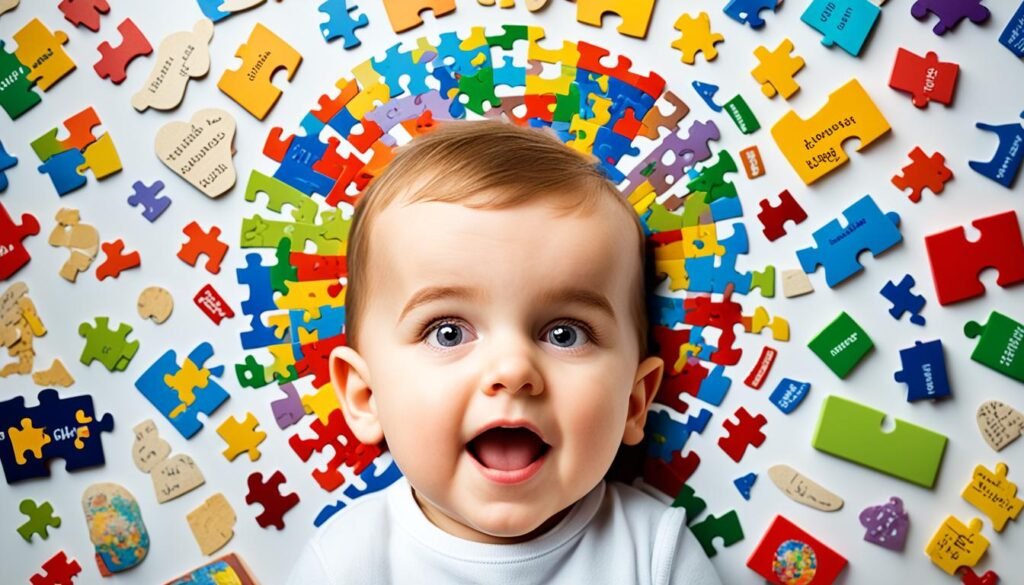
Age is key to the cognitive perks of speaking two languages. The way learning a second language affects our brains changes as we grow. Let’s see how bilingualism helps at different stages of life, from being young to being an adult.
Early childhood bilingualism
Young kids who speak two languages do amazingly well. They beat kids who speak just one in tasks like hearing and breaking down sounds28. This skill helps them learn more languages and read better later on.
Being bilingual also helps with memory. Kids who speak English and Spanish or English and French do better in reading tests28. This means they’re doing well in school and learning more.
Adult language learning and cognitive advantages
Many think it’s too late to start learning a new language, but that’s not true. Adults who learn a new language get big cognitive boosts. Studies show that those who are more advanced in English do better in tests that check thinking and memory29.
Adults who speak two languages are better at learning new words. They remember and find new words faster28. This is because they have a strong memory for sounds, which helps with learning more languages.
Lifelong bilingualism and its effects
Being bilingual keeps giving cognitive benefits as we age. A big study found that bilingual people have better focus, memory, and understanding of language29. These skills help keep the brain sharp, even as we get older.
Both kids and adults who speak two languages do better in thinking skills than those who speak one2829. Early starters usually do better and use their languages more, which helps more with these skills.
In conclusion, starting to learn a second language early is great, but it’s never too late. Learning a new language at any age makes our brains more flexible and sharp. Being bilingual is a lifelong way to keep improving our minds.
Bilingualism and Memory Function
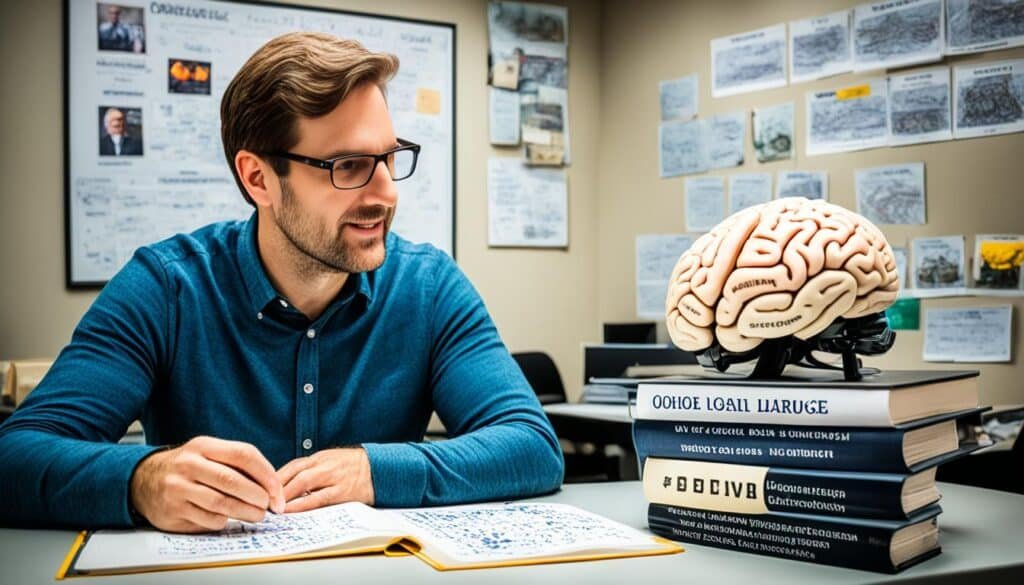
Bilingualism greatly affects memory, improving both working and long-term memory. Studies show that bilingual babies do better in memory tasks than those who speak one language30. This is because they quickly learn new things and store them in their memory30.
Being exposed to more languages makes memory more flexible in babies. This means they remember things better, even when things change around them30. This helps them learn new things faster. This advantage lasts into childhood, where bilingual kids do better in memory tests than those who speak one language31.
Language also shapes how we remember events. For example, using different verbs in questions about an accident can change how fast we remember it32. This effect is seen in bilingual people too. Their use of multiple languages affects how they remember and think about things32.
As people get older, bilingualism keeps giving memory benefits. Bilingual seniors have better memory than those who speak one language31. This helps them keep their minds sharp as they age.
In summary, bilingualism boosts memory in many ways, from short-term to long-term recall. These benefits start early and last a lifetime, showing how learning a second language changes how we remember things.
Cross-cultural Communication Skills in Bilinguals
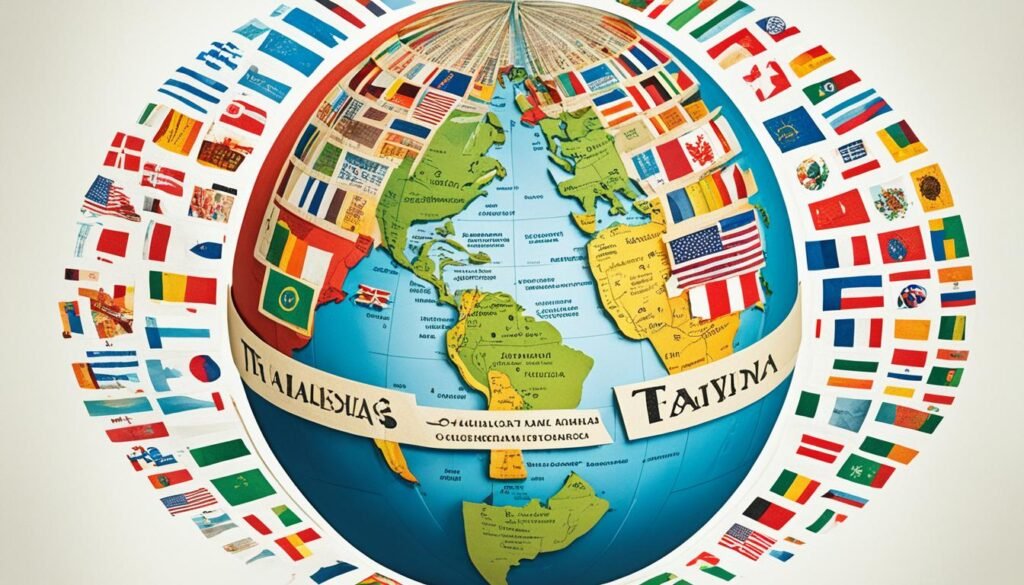
Bilinguals gain better skills in talking across cultures. In our global world, knowing how to communicate across cultures is key. The Penn Language Center offers courses in many languages, like African and South Asian tongues, American Sign Language, and languages for professionals33.
Learning about different cultures in language classes has become more important. Over the last 20 years, we’ve learned more about how language shapes who we are33. Now, teaching languages focuses more on how to communicate across cultures.
Bilinguals often have better thinking skills. They can pay attention and switch tasks easier than those who speak only one language34. This helps them a lot in real-life situations where they need to adapt.
Schools now see the value in teaching two languages. For example, the Ural Federal University makes learning a foreign language a must for all students, offering English, German, or French35. Some programs let students start learning two foreign languages right away, including Chinese, Japanese, and Arabic35.
Being bilingual does more than just improve language skills. Bilingual students are better at solving problems, thinking deeply, and being creative34. These skills help them communicate across cultures more effectively, making it easier to handle different cultural settings.
Challenges in Bilingualism Research
In my study of bilingualism, I’ve found many complex challenges. These challenges shape how we see this field. The debate on bilingual cognitive benefits has grown, with different studies causing discussions among experts.
Methodology Considerations
Methodology is a big challenge in bilingualism research. It’s important to define bilingualism clearly and control for factors like income. Since 2003, there has been a big increase in bilingualism studies. This has made it clear we need strong research methods for consistent results36.
Conflicting Study Results
There have been many mixed findings in cognitive science. Some studies say bilinguals do better in certain tasks. But others haven’t found the same results36. This shows how complex bilingual cognition is. We need more detailed research.
Future Research Directions
For the future, I think we should focus on long-term studies and advanced brain scans. Recent studies have shown interesting differences in bilingual brains. These differences relate to how much bilingualism is used37. These findings could lead to a better understanding of bilingual cognitive benefits.
FAQ
What is bilingualism and multilingualism?
Bilingualism means speaking two languages well. Multilingualism is when someone knows more than two languages.
How prevalent is bilingualism globally?
Over half of Europeans speak two languages, says the European Commission. In the U.S., about 20% speak a language other than English at home. Worldwide, there are around 6,800 languages, with many countries having more than one official language.
What is language co-activation?
Language co-activation means using multiple languages at once in a bilingual’s brain. This can make language processing easier and harder at the same time.
How does bilingualism enhance cognitive control?
Bilinguals get better at managing their languages. This helps them do tasks that need focus, quick language changes, and keeping track of information.
What is the relationship between bilingualism and executive function?
Bilinguals have better executive function. This includes working memory, controlling impulses, and changing plans easily. They do better on tests that check these skills.
How does bilingualism affect the brain?
Studies show bilingual brains work differently. They use more areas for language, have more gray matter in language areas, and keep white matter strong in older people.
Do bilinguals have enhanced learning capabilities?
Yes, bilinguals learn better in many areas. They pick up new words, artificial languages, and improve their thinking skills from an early age.
What is cognitive reserve, and how is it related to bilingualism?
Cognitive reserve means the brain’s ability to handle damage. Bilingualism helps build this reserve by making the brain more efficient and adaptable. This can delay Alzheimer’s and other brain problems.
Does bilingualism impact creativity?
Yes, bilinguals are more creative. They do better in nonverbal creativity and general creativity than those who speak only one language. But, this can depend on the culture.
How does bilingualism enhance cognitive flexibility?
Bilinguals are better at changing their thinking to fit different situations. This comes from managing two languages. They switch tasks faster and solve problems better.
What is the relationship between bilingualism and attention control?
Bilinguals have better attention control. They handle multiple languages well. This helps them focus better, ignore distractions, and hear clearly in noisy places.
Does the age of language acquisition impact bilingual cognitive benefits?
Yes, when bilinguals start learning a second language matters. Those who start young have more cognitive benefits. But even adults learning a new language can still improve their thinking skills.
How does bilingualism affect memory function?
Bilinguals have better memory in many areas. This includes remembering events and tasks. These memory skills help build cognitive reserve throughout life.
Does bilingualism foster cross-cultural communication skills?
Yes, bilinguals communicate better across cultures. They are more tolerant, empathetic, and can see things from different perspectives. This helps them get along in diverse cultures.
What challenges does bilingualism research face?
Research on bilingualism has challenges. It needs clear definitions, to control for social factors, and to deal with different study results. Future studies should use long-term designs, brain scans, and look at how bilingualism affects other brain functions.
